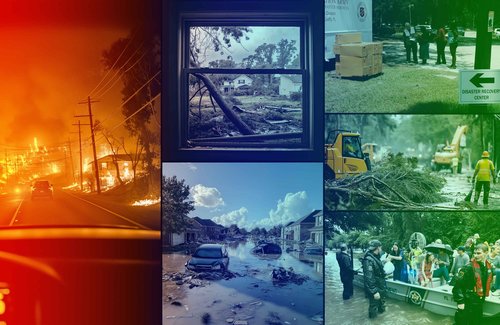
This assignment is for young people living through a natural disaster who have the desire and ability to tell a story about the event and its aftermath. Safety is paramount, so do not put yourself in harm’s way, however if you have a smartphone or another camera/device to record what’s happening around you, Student Reporting Labs wants to hear your story.
Review this short tutorial on how to film using your smartphone, and this tutorial about how to record a video diary.
Tell your own story: If possible, before the natural disaster or extreme weather event, describe how you and your family, friends and/or neighbors are preparing. What steps are you taking? How are you finding good information about what to do and where to go? Do you have to evacuate, gather emergency supplies, or shelter in place? How are you trying to stay safe during the event? In the aftermath, what has changed and how are you feeling? For inspiration check out Amira’s story about how Hurricane Maria affected her Puerto Rican community in 2017.
Tell a story about someone else who is helping: How are family, friends, community members pulling together? What kind of help are you receiving (or not receiving) from the local, state, and/or federal government? Are there community organizations, faith groups, and/or nonprofit organizations stepping in to provide support? What kinds of informal networks have popped up to take care of your community? How are you getting good information about what’s happening?
When telling your own story or interviewing another person, think about both the emotional and practical challenges of living through a natural disaster. How are you and those around you dealing with fear, uncertainty, loss, and change? What concrete steps need to be taken to keep people safe and get back to a sense of community healing or normalcy.
Extension activity: Several months after a natural disaster has occurred, interview someone working to re-open a school, business, place of worship, recreation center, or other community gathering place that was damaged. How are things going? What obstacles have they faced? Did they receive help? How are they feeling and what do they want others to know about their experiences? Capture their story.
This year, instead of submitting fully produced stories, SRL invites students to pitch their story ideas first.
PRO TIPS BEFORE BEFORE PITCHING YOUR STORY:
SUBMIT YOUR PITCH:
SUCCESSFUL PITCHES WILL:
If your pitch is selected, you will work with an SRL Youth Media Producer to further develop your story for publication. If selected, a team member will contact you within three weeks of your submission.
A subject or problem that people are thinking and talking about
A group of people who live in the same area (such as a city, town, or neighborhood). It can also be a group of people who have the same interests, religion, race, etc.
Immediate, current information and events are newsworthy because they have just recently occurred. It’s news because it’s “new.”
Local information and events are newsworthy because they affect the people in our community and region. We care more about things that happen “close to home.”
Investigating and explaining, in a critical and clear-eyed way, how people try to solve widely shared problems. Solutions journalism focuses on responses to problems.
People are interested in other people. Everyone has something to celebrate and something to complain about. We like unusual stories of people who accomplish amazing feats or handle a life crisis because we can identify with them.
A conversation between two or more people where the purpose is to gather information and facts. The interviewer asks questions and the interviewee provides information based on their knowledge about a specific topic or issue.
The term “empathy” is used to describe a wide range of experiences. A generally definition is the ability to sense other people’s emotions, coupled with the ability to imagine what someone else might be thinking or feeling. In media-making, creators can have empathy for their subjects and the audience can empathize with the characters.
The primary video and audio that drives your story from beginning to end.
A selection of separate sections of video that form a continuous, edited piece.
A person who has a comprehensive and authoritative knowledge of or skill in a particular area.
Non-fiction video or audio communication about topics of public interest disseminated through broadcast or digital methods including tv, radio, streaming, and social media.
Historical inquiry is based on materials left from the past that can be studied and analyzed. (NCSS D2.His.9.9-12 - D2.His.13.9-12)
Determine the kinds of sources that will be helpful in answering compelling and supporting questions, taking into consideration multiple points of view represented in the sources, the types of sources available, and the potential uses of the sources. (NCSS D1.5.9-12)
Analyze a major global challenge to specify qualitative and quantitative criteria and constraints for solutions that account for societal needs and wants. (NGSS HS-ETS1-1)
Construct an explanation based on evidence for how the availability of natural resources, occurrence of natural hazards, and changes in climate have influenced human activity. (NGSS HS-ESS3-1)
At its heart, chronological reasoning requires understanding processes of change and continuity over time, which means assessing similarities and differences between historical periods and between the past and present. (NCSS D2.His.1.9-12 - D2.His.3.9-12)
Whether students are constructing opinions, explanation, or arguments, they will gather information from a variety of sources and evaluate the relevance of that information. (NCSS D3.1.9-12 - D3.2.9-12)
Communicate scientific information that common ancestry and biological evolution are supported by multiple lines of empirical evidence. (NGSS HS-LS4-1)
Climate Change
Video Production
Science
STEM
Beginner
Intermediate
Advanced
Mic
Video Conference Software. IE: Zoom or Google Meet
Camera or Mobile Phone
Notebook
4-6 weeks